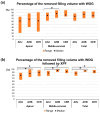Retrieval of AH Plus Bioceramic and Ceraseal Versus AH Plus in Endodontic Retreatment
- PMID: 40142636
- PMCID: PMC11942721
- DOI: 10.3390/jcm14061826
Retrieval of AH Plus Bioceramic and Ceraseal Versus AH Plus in Endodontic Retreatment
Abstract
Background/Objectives: Since biomineralization by calcium silicate-based sealers (CSBSs) was reported, retrieving canal filling materials may be challenging during endodontic retreatment due to their adhesion to dentin. This study aimed to evaluate the possibility of removing residual mineral deposits from two kinds of CSBSs compared to the AH Plus Jet (AHJ). Methods: Root canals of mandibular premolars were prepared, obturated with the sealer-based obturation method using a WOG medium gutta-percha cone and one of the following sealers: AHJ, AH Plus Bioceramic (AHB), and Ceraseal (CER) (n = 12/group). After 3 weeks, endodontic retreatment was conducted with the WOG files, followed by instrumentation with XP-endo Finisher (XPF). Micro-computed tomography scanning was obtained after canal filling, after retreatment with WOG, and after the use of XPF. The percentage of the removed filling volume was calculated. One-way ANOVA with Tukey's test and a non-parametric test with Bonferroni's correction were performed. Root canal dentin after retreatment was examined using a scanning electron microscope (SEM). Results: After supplementary instrumentation with XPF, the mean residual filling volumes for the AHJ, AHB, and CER groups were 1.35 mm3, 0.55 mm3, and 0.82 mm3, respectively. The AHJ group showed greater residual volume compared to the AHB group (p < 0.05). The AHB and CER groups demonstrated higher mean percentages of removed filling volume at 94.8%, and 92.5%, respectively, compared to 87.1% for the AHJ group (p < 0.05). More mineral deposits were observed in the CER group with SEM. Conclusions: AHB and CER are retrievable during endodontic retreatment, with CER preferable due to greater mineral deposits in dentinal tubules.
Keywords: XP-endo finisher; calcium silicate-based sealer; endodontic retreatment; micro-computed tomography; reciprocating nickel-titanium file; root canal sealer.
Conflict of interest statement
The authors declare no conflicts of interest.
Figures






References
-
- López-García S., Myong-Hyun B., Lozano A., García-Bernal D., Forner L., Llena C., Guerrero-Gironés J., Murcia L., Rodríguez-Lozano F.J. Cytocompatibility, bioactivity potential, and ion release of three premixed calcium silicate-based sealers. Clin. Oral. Investig. 2020;24:1749–1759. doi: 10.1007/s00784-019-03036-2. - DOI - PubMed
Grants and funding
LinkOut - more resources
Full Text Sources

